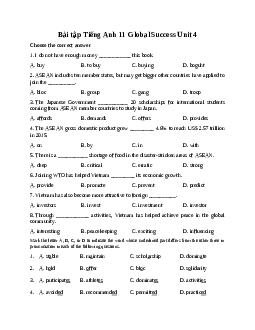



Preview text:
Tiếng Anh 11 Global Success Unit 4 Communication and Culture/ CLIL Everyday English
Giving and responding to compliments
(Đưa ra lời khen và đáp lại lời khen)
1. Listen and complete the conversation with the expressions in the box. Then practise it in pairs.
(Nghe và hoàn thành cuộc hội thoại với các biểu thức trong hộp. Sau đó thực hành nó theo cặp.) Gợi ý đáp án 1. C 2. A 3. D 4. B
2. Work in pairs. Use the model in 1 to make similar conversations for these
situations. One of you is Student A, the other is Student B. Use the expressions below to help you.
(Làm việc theo cặp. Sử dụng mô hình trong phần 1 để tạo các hội thoại tương tự cho các
tình huống này. Một trong số các bạn là Học sinh A, người kia là Học sinh B. Sử dụng
các biểu thức dưới đây để giúp bạn) Gợi ý đáp án
1. A: I just submitted my report on ASEAN. I'm hoping to get a good grade on it.
B: Wow, this report is amazing! You did an excellent job on the research and the writing is very clear.
A: Thank you so much for the compliment. I put a lot of effort into it, so it's great to hear that it's appreciated.
2. B: I recently organized a workshop on skills for future leaders in ASEAN.
A: That sounds really interesting. How did it go?
B: It went really well! I received a lot of positive feedback from the participants.
A: That's great to hear! You did an excellent job with the organization and the content was very informative.
B: Thank you, that means a lot coming from you. I put a lot of time and effort into making sure it was a success. Culture
1. Read the text and complete the table below.
(Đọc văn bản và hoàn thành bảng dưới đây.) Gợi ý đáp án
(1) Viet Nam, Singapore, Indonesia, and parts of Malaysia (2) April
(3) Honour ancestors, family gathering, big family meal, wishing for prosperity,
decorations, fireworks, parades, street parties, and art performances.
(4) Offering rice to Buddhist monks, receiving wishes for good luck and health, home
decorations, traditional dishes, water splashing, art performances, folk games, and dancing.
2. Work in pairs. Discuss the similarities and differences between the New Year
Festivals in Viet Nam and other ASEAN countries.
(Thảo luận về những điểm tương đồng và khác biệt giữa Tết Nguyên Đán ở Việt Nam và các nước ASEAN khác.) Gợi ý đáp án
The New Year Festivals in Viet Nam and other ASEAN countries have some similarities
and differences, which are outlined below. Similarities:
Both Viet Nam and other ASEAN countries celebrate their New Year Festivals to
honour their ancestors and wish for good luck, prosperity, and health for the year to come.
The New Year Festivals in both Viet Nam and other ASEAN countries involve
family gathering, big family meals, decorations, and art performances.
Fireworks are lit to scare away bad luck during the Lunar New Year celebrations in
Viet Nam, Singapore, Indonesia, and parts of Malaysia, while water is used to wash
away bad luck during the New Year celebrations in Laos, Cambodia, Thailand, and Myanmar. Differences:
The time of the New Year Festivals in Viet Nam and other ASEAN countries is
different. Viet Nam, Singapore, Indonesia, and parts of Malaysia celebrate their New
Year Festivals in January or February according to the lunar calendar, while Laos,
Cambodia, Thailand, and Myanmar celebrate theirs in April according to the Buddhist calendar.
The way of offering respect to ancestors and receiving wishes for good luck and
health is different between Viet Nam and other ASEAN countries. In Viet Nam,
people burn incense and offer food and drinks to their ancestors at home altars or
temples, while in Laos, Cambodia, Thailand, and Myanmar, people offer rice to
Buddhist monks and receive wishes from them.
The New Year Festivals in Viet Nam and other ASEAN countries have different
traditional dishes. For example, in Viet Nam, people usually eat sticky rice cakes and
boiled chicken, while in Laos, Cambodia, Thailand, and Myanmar, people eat various
traditional dishes such as papaya salad, fish soup, or sticky rice balls.
In summary, while there are some similarities between the New Year Festivals in Viet
Nam and other ASEAN countries, the differences in timing, customs, and traditional
dishes reflect the unique cultural identities of each country.




